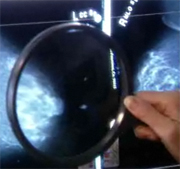
TUESDAY, Dec. 15 (HealthDay News) — When it comes to diagnosing breast cancer, women and their doctors have some options, but new research suggests that the less invasive “core needle biopsy” procedure is nearly as effective in diagnosing breast cancer as an open surgical procedure is, with fewer complications than the surgical version.
The new analysis, scheduled to published in the Jan. 5 issue of Annals of Internal Medicine, looked over data from more than 100 studies comparing different biopsy methods. It found that core needle biopsy and surgical biopsy provided women with roughly similar results.
“Our findings were that any core needle biopsy has a lower risk of complications, and was almost as accurate as surgical biopsy,” said the study’s principal investigator, Wendy Bruening, the associate director of the ECRI Institute Evidence-based Practice Center in Plymouth Meeting, Penn.
Additionally, Bruening said that “women diagnosed with core needle biopsy were more likely to be treated with just one surgical procedure.”
The U.S. government’s Agency for Healthcare Research and Quality commissioned and funded the study.
Biopsies are only done after other tests, such as a mammogram, suggest that breast cancer might be present. In any biopsy procedure, a sample is taken from the suspicious area and examined for signs of malignancy.
An “open” surgical biopsy can be done using either general or local anesthesia, explained Dr. Karen Stanford, a surgeon at the Brooklyn Hospital Center in New York City. During this procedure a scalpel is used to open the skin so that the sample can be taken. Because it’s a surgical procedure, scarring is a likely complication.
Core needle biopsy, on the other hand, uses a large needle with a hollow center to draw out a “core” sample from the suspicious lesion. This procedure is done using local anesthesia, Stanford said.
The 107 studies included in Bruening’s analysis examined more than 57,000 breast lesions.
Although the researchers felt that many of the studies didn’t meet the standards to provide a high level of evidence, they were generally large and consistent enough to conclude that the results indicate that core needle biopsy is nearly as accurate as a surgical biopsy.
The researchers found that the rate of complications for core needle biopsy was less than 1 percent while surgical biopsy complication rates were between 2 and 10 percent.
“No biopsy method is completely accurate, but the available methods are close in accuracy,” said Bruening, who added, “Women usually prefer core needle biopsy.”
And, most women have the option of having core needle biopsy, said Stanford, who noted that core needle biopsy is her preferred procedure.
“Most of the time, core needle biopsy is reliable enough to gather information about the diagnosis, and it may be the only procedure that women need because most breast biopsies are negative. For that reason, if we can do a minimal procedure, it’s best for patients,” said Stanford.
Bruening and her colleagues recommended that women talk with their doctors about which option might be best for them.
More information
The American Cancer Society explains the different tests used to diagnose breast cancer.

